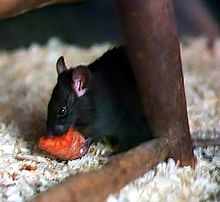Muridae: Difference between revisions
Reverted 1 edit by 222.154.100.152; Restore deleted word. using TW |
Betacommand (talk | contribs) m Adding: fr, hu, oc, sah, uk |
||
| Line 99: | Line 99: | ||
[[Category:Muroid rodents]] |
[[Category:Muroid rodents]] |
||
{{nobots}}<!--Bad interwiki links are continuously added.--> |
{{nobots}}<!--Bad interwiki links are continuously added.--> |
||
[[ar:فأريات]] |
[[ar:فأريات]] |
||
[[az:Siçankimilər]] |
[[az:Siçankimilər]] |
||
| Line 108: | Line 109: | ||
[[es:Muridae]] |
[[es:Muridae]] |
||
[[eo:Musedoj]] |
[[eo:Musedoj]] |
||
[[fr:Muridae]] |
|||
[[ko:쥐과]] |
[[ko:쥐과]] |
||
[[id:Tikus]] |
[[id:Tikus]] |
||
| Line 118: | Line 120: | ||
[[lt:Peliniai]] |
[[lt:Peliniai]] |
||
[[li:Moesechtege]] |
[[li:Moesechtege]] |
||
[[hu:Egérfélék]] |
|||
[[mk:Глувци]] |
[[mk:Глувци]] |
||
[[nl:Muridae]] |
[[nl:Muridae]] |
||
| Line 123: | Line 126: | ||
[[no:Musefamilien]] |
[[no:Musefamilien]] |
||
[[nn:Musefamilien]] |
[[nn:Musefamilien]] |
||
[[oc:Muridae]] |
|||
[[pl:Myszowate]] |
[[pl:Myszowate]] |
||
[[pt:Muridae]] |
[[pt:Muridae]] |
||
[[qu:Chupasapa ukucha]] |
[[qu:Chupasapa ukucha]] |
||
[[ru:Мыши]] |
[[ru:Мыши]] |
||
[[sah:Кутуйахтыҥылар кэргэннэрэ]] |
|||
[[simple:Muridae]] |
[[simple:Muridae]] |
||
[[sv:Råttdjur]] |
[[sv:Råttdjur]] |
||
[[ta:எலிக்குடும்பம்]] |
[[ta:எலிக்குடும்பம்]] |
||
[[uk:Мишині]] |
|||
[[zh:鼠科]] |
[[zh:鼠科]] |
||
Revision as of 04:12, 1 July 2010
| Muridae Temporal range: [citation needed] | |
|---|---|

| |
| Black Rat (Rattus rattus) | |
| Scientific classification | |
| Kingdom: | |
| Phylum: | |
| Class: | |
| Order: | |
| Superfamily: | |
| Family: | Muridae Illiger, 1811 |
| Subfamilies | |
Muridae is the largest family of mammals. It contains over 600 species found naturally throughout Eurasia, Africa, and Australia. They have been introduced worldwide. The group includes true mice and rats, gerbils, and relatives.
The family name Muridae is sometimes used in a broader sense to include all members of the superfamily Muroidea. The name comes from the Latin mus (genitive muris), meaning "mouse".
Characteristics
The murids are small mammals, typically around 10 cm (3.9 in) long excluding the tail, but ranging from 4.5 to 8 cm (1.8 to 3.1 in) in the Pygmy Mouse to 48 cm (19 in) in Cuming's Slender-tailed Cloud Rat. They typically have a slender body with a scaled tail, and pointed snouts with prominent whiskers. However, within these broad traits, there is a wide degree of variation. Many murids have elongated legs and feet allowing them to move with a hopping motion, while others have broad feet and prehensile tails to improve their climbing ability, and yet others have neither adaptation. They are most commonly some shade of brown in colour, although many have black, grey, or white markings[1].
Murids generally have excellent senses of hearing and smell. They live in a wide range of habitats from forest to grassland, and mountain ranges. A number of species, especially the gerbils, are adapted to arid desert conditions, and can survive for a long time with minimal water. They are either herbivores or omnivores, eating a wide range of foods in different species, with the aid of powerful jaw muscles and gnawing incisors that grow throughout life. The dental formula of murids is: 1.0.0.1-31.0.0.1-3
Murids breed frequently, often producing large litters several times per year. They typically give birth between 20 and 40 days after mating, although this varies greatly between species. The young are typically born blind, hairless, and helpless, although there are exceptions, such as the spiny mice[1].
Evolution
As with many other small mammals, the evolution of the murids is not well known, as few fossils survive. They probably evolved from hamster-like animals in tropical Asia some time in the early Miocene, and to have only subsequently produced species capable of surviving in cooler climes. They have become especially common worldwide during the Holocene, as a result of hitching a ride with human migrations[2].
Classification
The Murids are classified in 5 subfamilies, around 140 genera and approximately 650 species.
Subfamilies
- Deomyinae (spiny mice, brush furred mice, link rat)
- Gerbillinae (gerbils, jirds and sand rats)
- Leimacomyinae (Togo Mouse)
- Lophiomyinae (Crested Rat)
- Murinae (Old World rats and mice including the vlei rats)
References
- ^ a b Berry, R.J. & Årgren, G. (1984). Macdonald, D. (ed.). The Encyclopedia of Mammals. New York: Facts on File. pp. 658–663 & 674–677. ISBN 0-87196-871-1.
{{cite book}}: CS1 maint: multiple names: authors list (link) - ^ Savage, RJG, & Long, MR (1986). Mammal Evolution: an illustrated guide. New York: Facts on File. p. 124. ISBN 0-8160-1194-X.
{{cite book}}: CS1 maint: multiple names: authors list (link)
- Jansa, Sharon. A.; Weksler, Marcelo (2004), "[[Phylogeny]] of [[Muroidea|muroid]] [[rodent]]s: relationships within and among major lineages as determined by IRBP [[gene]] sequences" (PDF), Molecular Phylogenetics and Evolution, 31 (1): 256–276, doi:10.1016/j.ympev.2003.07.002
{{citation}}: URL–wikilink conflict (help). - Michaux, Johan; Reyes, Aurelio; Catzeflis, François (1 November 2001), "Evolutionary History of the Most Speciose Mammals: Molecular [[Phylogeny]] of Muroid [[Rodent]]s", Molecular Biology and Evolution, 18 (11): 2017–2031, ISSN 0737-4038, PMID 11606698
{{citation}}: URL–wikilink conflict (help). - Steppan, Scott; Adkins, Ronald; Anderson, Joel (2004), "Phylogeny and Divergence-Date Estimates of Rapid Radiations in Muroid Rodents Based on Multiple Nuclear Genes" (PDF), Systematic Biology, 53 (4): 533–553, doi:10.1080/10635150490468701.
- Muridae on ITIS
